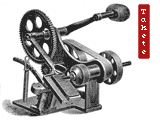
DONUTS, CARS & COFFEE
- The building blocks that shaped a nation
With Footnotes by the Colonel
My good friend the Colonel always used to say that the Unites States is a nation stuck in it’s oral phase - To familiarise ourselves with this concept, let’s hear what Sigmund Freud has to say:
“The oral phase begins at birth and lasts eight months. It is characterized by the infant’s concern for his mouth and gratification he feels from oral stimuli. The most obvious oral activity the child derives pleasure from is eating. Oral stimulation, however, is also produced by engaging in such activities as sucking, biting, swallowing and manipulating various parts of the mouth. Freud contended that these activities are The child’s means of fulfilling his sexual urges. Hence, Eros (the life instinct) makes its appearance. But Thanatos (the death instinct) is also seen since quite frequently children destroy objects they come in contact with, often by biting them.”
With the risk of sounding political, The Primary narcissism, Need-satisfying, and paranoid - schizoid position of the Oral Phase helps somewhat in explaining the current social policies of the US, specifically in areas where consumerism is influencing lifestyle choices and habits, resulting indirectly in shaping the American marketplace for durable goods, (such as automobiles) and food products.
The theory we would like to put forward is that this is all directly attributed to the automatic gearbox, released by General Motors in 1940. Without this innovation the American consumer wouldn’t be able to drive with one hand free, ready to feed her every oral whim.
It is due to the very absence of “a stick” that this great nation can give in to the ease of oral gratification in only the way that 16 ounces of coffee in an insulated container can deliver. Europeans, as you know, have to keep their free hand ready for the gear stick.
The frequency of gear changes is in other words in direct correlation with the size and strength of one’s coffee.
The more one has to change gears, the smaller the size coffee. That’s why you get the best espresso in Italy, a place renowned for its rule-breaking driving style.
The stick in the shape of a policeman’s baton - at the end of which a donut is dangling, perhaps - is our only reminiscence of a time where other fixations, not associated with the oral orifice, still roamed in the land of the free. How the “donut/baton” model grew to be the most active and rewarding model for examining contemporary theories of the self,and how it ended up so intrinsically tied to officers of law enforcement is a complicated issue, and one that we can only briefly touch on at present. The Donut of course needs a book-length monograph of its own, at the very least, a project I call my more astute scholarly colleagues to now consider.
Suffice to say that the drive-through is as important an American architectural achievement as the Pentagon or the Empire State Building. When the Red Light of the Krispy Kreme Donut Store is switched on, a line of cars is instantly queueing up outside, like sailors outside a seedy harbour bordello. “All the Doughnuts have names that sound like Prostitutes”, as the song goes.
To the American citizen the donut subconsciously represents a wish to change, a transitional stage between the 16oz venti semi-skim latte and the 2oz espresso. Baked goods are now beginning to act as transformational objects, allowing the American populous to change their dining and driving habits.[1]
Thusly, by not concentrating solely on the oral intake of fluids, and aided by the tight round muscle of the donut the step out of Freuds Oral phase is facilitated.
I put it to you, dear reader, that ideally, and perhaps controversially, we all need to be more like the French.
Their confectionery of choice is nothing like a donut. It’s a good sized Baguette,[2] indicating a nation that is over the Oral and Anal phases, one that proudly has passed over into Freuds Phallic Phase.
And there they will stay until Latency.
[1] The problem of this line of reasoning is that the only proper accompaniment to a donut or two is a cup of coffee. Both are eaten together, by police officers and civilians alike, regardless of whether or not the car is moving. The donut does not displace the coffee, it merely supplements it. Eating, drinking, AND driving alas now take place simultaneously.
[2] The problem here is that what we should be talking about is the croissant. Baguettes are simply bread. The croissant is a pastry. It is the half moon which watches over us all, the buttery baked memory of the heyday of the French colonial empire, the ideal receptacle of the filling of your choice. And I don’t see how this would fit into the Phallic proposition: instead I might argue its adoption and widespread popularity somehow acts as a reaction to the numerous emasculations of both daily life in a heavily centralized, bureaucratic state like France, and also of the wistful memories of Empire. So perhaps that might be one way around this: “croissant as phallic transference in contemporary French identity.” But of course the croissant came about as a residual reminder of the (Catholic) French victories over the invading Muslim infidels during the Crusades, so there is more than recent history at work here.
- Previous: THE NOVEMBER BEARD CLUB